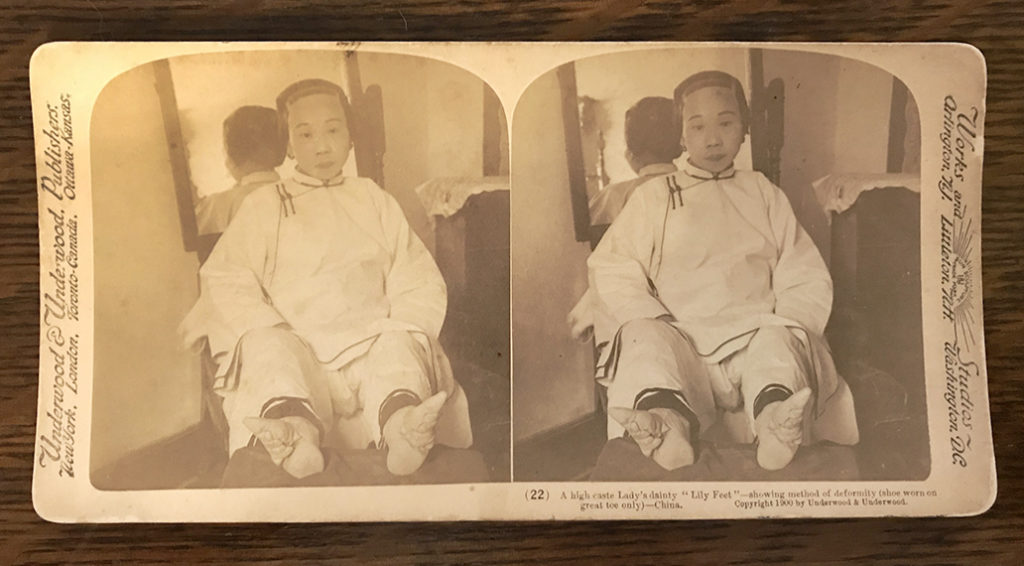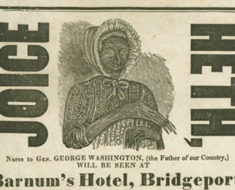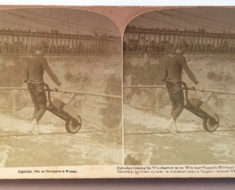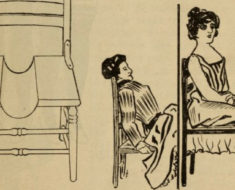
Stereoview of Chinese “Lily Feet.” With a viewer, you can see her unwrapped feet in 3D. Marc Hartzman Collection.
For nearly a thousand years, women in China were subjected to the practice of foot binding. The tradition began more than a thousand years ago during the Song Dynasty and continued into the early 20th century.
Young girls’ feet were tightly wrapped, misshaping them over the years to achieve what was perceived as a status symbol and a mark of beauty. The process usually began between the ages of 4 and 9, and caused pain, infections, and difficulty in walking.
One belief regarding the origin of foot binding surrounds a story in the year 501 about Empress Pan Fei, whose feet were very small. She displayed their beauty by walking over a crimson cloth decorated with golden lilies. The Emperor proclaimed that “each footstep made a lily grow.” Other women in the empire wanted “golden lily” feet. As described in an 1894 article, the women “began squeezing in her feet, just as the foolish women of today do their waists.”
Another tale surrounds the 10th-century Emperor Li Yu, who created a six-foot tall golden lotus adorned with precious stones and had his concubine’s feet bound in white silk to be shaped like a crescent moon. He then had her dance on her toes over the lotus. This dance was said to be so elegant and graceful that others wished to do the same. Upper class women began binding their feet and the custom spread.
![X-ray of bound feet. By unknown; Frank and Frances Carpenter Collection. [Public domain], via Wikimedia Commons.](http://www.weirdhistorian.com/wp-content/uploads/2018/06/1024px-Bound_feet_X-ray.jpg)
X-ray of bound feet. By unknown; Frank and Frances Carpenter Collection. [Public domain], via Wikimedia Commons.
The question is, why?
In Songling Pu’s 1740 book, Strange Stories from a Chinese Studio, he explains (as translated by Herbert Giles) that even after men in China converted to Christianity and began to absorb elements of western culture, they “cannot yet throw off the admiration for ‘golden lily’ feet.”
He offers seven arguments from a native convert in support of the misshapen feet:
In the first place, people say that a girl with natural feet is like a boy, and they laugh at her.
Secondly a girl should walk gracefully, with mincing steps, swaying like a willow, thus showing herself a ‘person of respectability.’ One who ‘walks noisily is called names.’
Third, a man of good family does not wish for a bride with long feet.
Fourth, a woman who has not ‘perfect’ feet has to do rough work, ‘does not sit in a sedan chair, has no red clothes, does not eat the best food.’ She has no fame or honour.
Fifth—very serious, no doubt, with parents—some women with long feet do escape rough work, do wear gay clothes, do ride in a sedan, etc.; if a girl’s feet were unbound she cannot be distinguished from one of these creatures.
Sixth, girls are like gold—they ought to stay in their own house. With long feet they go up and down and make undesirable acquaintances.
Sometimes parents think small feet attractive, and therefore command a higher price in the marriage market.”
Songling Pu laments the continued practice, commenting, “It will be long before humanity, or common sense, or even convenience, prevails against them.”
He was right. Cultural attitudes take time to shift, and it wasn’t until the mid 1900s that the practice fully disappeared. By 1999, the last shoe factory making lotus shoes closed.






